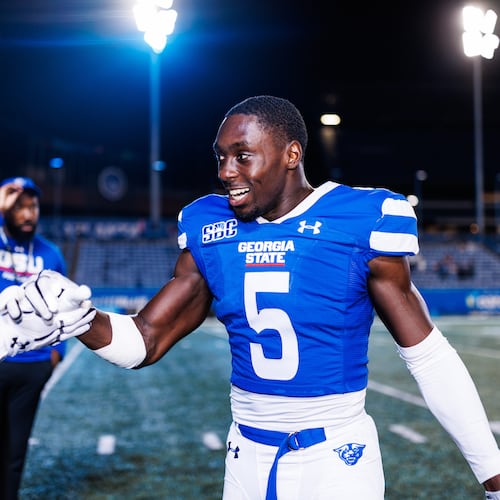Before Temple’s 2017 season, team publicist Rich Burg had some news for first-year coach Geoff Collins. For the benefit of media covering his team’s games, Collins needed to provide a depth chart.
“He asked me, ‘Why do we have to do it?’” Burg said Tuesday.
Burg informed him that it was required. Collins responded that who started – normally the most pertinent information in a depth chart – wasn’t as important as which players were going to play. And from there, Collins’ “Above the Line” chart was born.
“The title (of the chart) was all Geoff,” Burg said.
Released for the first time at Tech on Sunday, the unconventional chart has confounded and aggravated many accustomed to a standard two-deep depth chart and perhaps lacking an explanation of Collins’ methodology. But Collins sees his way of denoting which players are expected to play in a way as more logical and beneficial.
“It doesn’t necessarily mean they’re all going to play over 15 or 20 plays, but they’re the guys that we feel confident getting into the rotation going forward,” Collins said.
The “ATL” list is divided by position group, with players at each ordered by jersey number, not by likelihood of playing. Expected starters or specific positions for multi-position units are not highlighted in any particular way, which is particularly complicating for people (i.e., media and Clemson’s coaching staff) trying to figure out who is likely to play the most and where. For instance, the offensive-line list has 10 players, but no indication as to which position on the line they’ll play. (After the opener, starters from the previous game will be listed in bold-face.)
Tech’s ATL list for Thursday’s season opener at Clemson has 33 players on offense and 28 on defense. By comparison, Clemson’s depth chart has 28 on offense and 30 on defense. But the Tigers’ chart lists starters for all 22 positions with backups listed beneath them.
For that reason among others, Clemson coach Dabo Swinney was prompted to say Monday at his news conference that there were “a lot of unknowns” regarding the Yellow Jackets.
But the ATL chart is an insight into Collins and his way of thinking. His contention that who starts isn’t important to him isn’t mere coach-speak. Burg, the Temple publicist, said that Collins often held up former Owls defensive lineman Jullian Taylor as an example. In 2017, Taylor was by far the most productive defensive tackle on the team and was selected in the seventh round of the 2018 NFL draft, but was only a part-time starter.
It is also an expression of his “competition is king” mantra. Having a starter/backup depth chart, he has said, creates a hierarchy. That can foster a situation in which backups perhaps are less motivated to prepare, knowing they won’t be counted on as much. Not listing a starter, Collins reasons, speaks to the ongoing competition for playing time.
“So our goal for them is just to always be mentally ready,” safeties coach Nathan Burton said. “It’s important to be above the line, because you’re going to play if you’re above the line.”
Collins also asserted that his method fosters unity among players at the same position. Players above the line can be secure in knowing they’ll receive playing time and hence be more supportive of others at their position.
“The second you set starters and you set backups and you define those situations, sometimes that becomes contentious,” he said.
To the degree that the first three games of Temple’s 2018 season is an indicator, Collins came close to playing every player that was listed above the line prior to each game.
He played 56 of 61 ATL players for the opener (a loss to Villanova), 56 of 63 for the second game (a loss to Buffalo) and 58 of 63 for the third game (a win over Maryland). Four backups did not get into any of the three games, two punters, an offensive lineman and a fullback. Excluding those four, whose playing time for the remainder of the season suggests they were emergency players, 97 percent of players on the three ATL lists got playing time.
Because it was so comprehensive and typically accurate, Burg said that Collins’ ATL chart at Temple actually was more useful than a standard depth chart.
“It’s possible that, when he did it, he thought he was hiding something, but as someone who saw his team play for two years, I think he’s unveiling a lot more than he’s hiding,” he said.
Tech defensive coordinator Andrew Thacker said that the staff meets two days before the game to discuss who will play in which situations and in what pattern. For instance, while freshman linebacker Demetrius Knight will play defensive snaps, coaches likely will ensure that he won’t play his first snaps with other inexperienced players surrounding him.
“So there’s a science to it,” Thacker said.
On Thursday night, it won’t be a surprise if some of the freshmen who are above the line but whom Collins is uncertain (or certain) about redshirting don’t play. Punter Cliff Gandis probably won’t take playing time away from All-ACC punter Pressley Harvin. A couple of the 10 offensive linemen also may not see the field. And game circumstances may dictate other omissions.
On the other hand, it seems likely that more than one of the quarterbacks – Lucas Johnson, Tobias Oliver and James Graham – will play, either as a quarterback or at another position. Collins has indicated as much and also described them on his radio show Monday night as three of the top 25 players on the team.
Thacker said he’ll play a “minimum of 22” players on defense.
But which 22, and how much?
Clemson will have to wait until Thursday to figure that out.
About the Author
Keep Reading
The Latest
Featured

